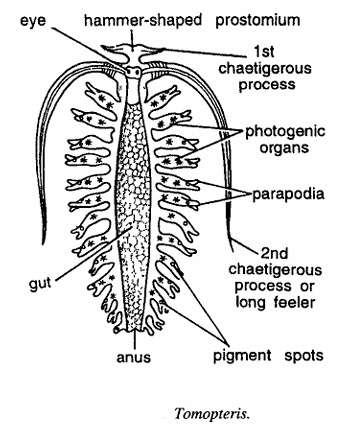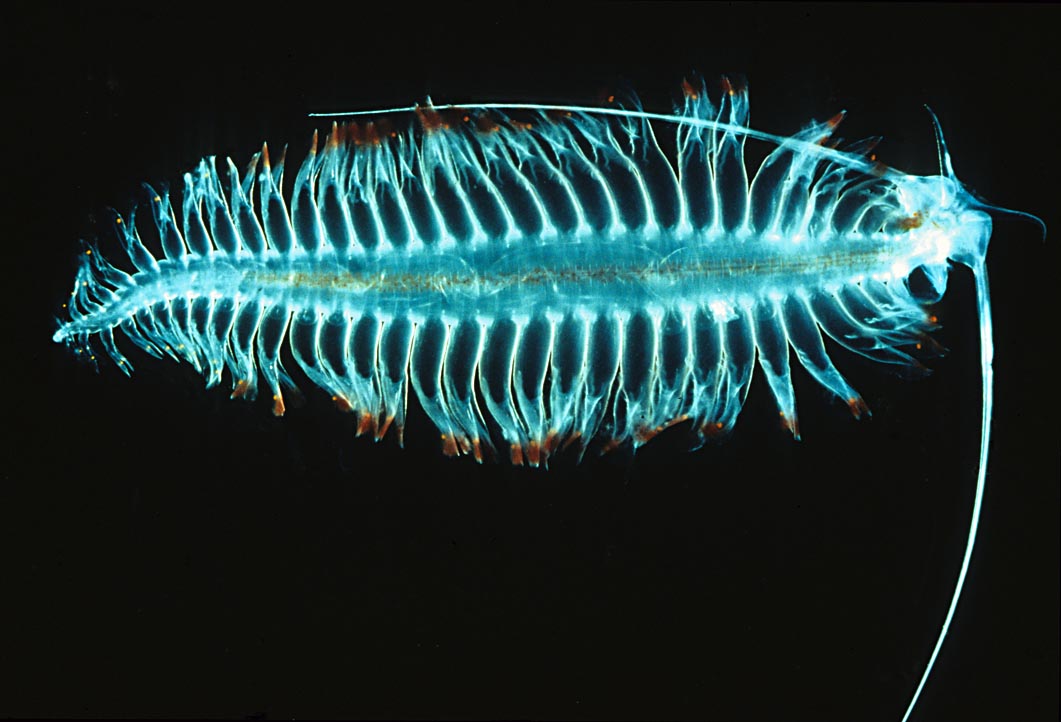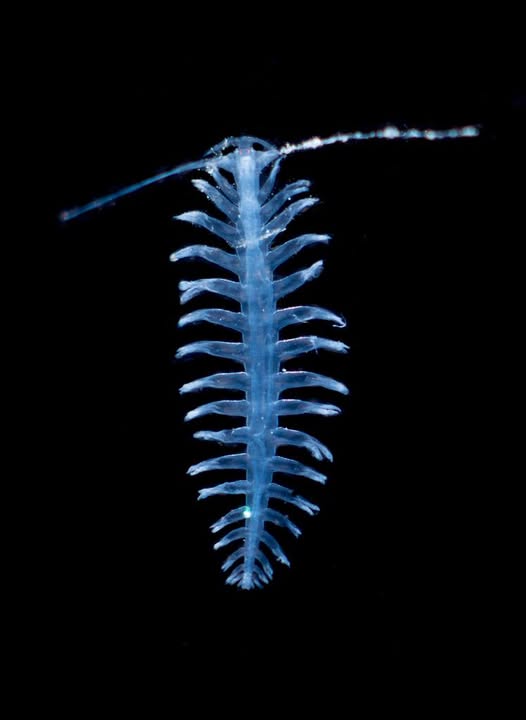Tomopteris: The Gossamer Worm – Morphology, Classification, Habitat, and Ecological Insights
Tomopteris, commonly referred to as the gossamer worm, is a fascinating genus of marine planktonic polychaete worms belonging to the family Tomopteridae. Ever since its scientific naming, meaning “a cut wing” or “fin” in Greek, Tomopteris has drawn considerable interest due to its unique adaptations to a fully pelagic lifestyle. Unlike many polychaetes that spend parts of their life cycle on the ocean floor, Tomopteris species are holoplanktonic, remaining in the water column throughout their lives. Their transparent bodies, yellow bioluminescence, and efficient swimming mechanisms make them exceptional inhabitants of the open ocean, often overlooked yet crucial components of planktonic ecosystems.
Classification of Tomopteris
| Taxonomic Rank | Name | Characteristics |
|---|---|---|
| Kingdom | Animalia | Multicellular organisms with specialized tissues |
| Phylum | Annelida | Segmented worms with metameric body plan |
| Class | Polychaeta | Marine worms with parapodia bearing setae |
| Order | Phyllodocida | Polychaetes with well-developed parapodia and sensory structures |
| Family | Tomopteridae | Holoplanktonic polychaetes with fin-like parapodia |
| Genus | Tomopteris | Gossamer worms adapted for pelagic life with transparent bodies |

Habit and Habitat
Tomopteris species are found exclusively in the pelagic zone of marine environments, from surface waters down to mesopelagic depths (ranges can exceed 1000 meters). Unlike benthic polychaetes, these worms float and swim actively within the open ocean. Their habitat extends globally, inhabiting temperate and tropical seas.
The genus thrives in the planktonic community where they play active predatory roles, feeding on smaller plankton, fish larvae, and other microscopic organisms. Their highly adapted swimming apparatus allows them to maintain position and navigate within the dynamic layers of the ocean.
Geographical Distribution
Species of Tomopteris are cosmopolitan, distributed widely across the Atlantic, Pacific, and Indian Oceans, including seas such as the Mediterranean and North Sea. Their planktonic nature ensures dispersal over vast distances, contributing to near-global presence. Different species have been described from various oceanic regions, with some common in colder waters like the North Sea, while others inhabit tropical zones.

General Characteristics
- Body of the animal is transparent consisting of 18-20 segments
- Anterior end or head is distinct due to the presence of hammer-shaped prostomium which contains a pair of eyes and two pairs of chaetigerous processes or tentacular cirri.
- The posterior ones are very much elongated while anterior ones are short.
- Ventral mouth is without proboscis or jaws. Blood vascular system is also absent.
- Rest of the body segments possess a pair of parapodia. The parapodia are large biramous with membranous pinnules and are without setae.
- Each parapodium contains a brightly coloured, yellowish, spherical or rosette-shaped bioluminescent (photogenic) organ.
- The parapodia of the posterior side are reduced. Mouth leads into buccal cavity which leads into gut. Gut opens to outside by anus.
- Body Form: Elongated, translucent, and laterally compressed with a streamlined morphology.
- Size: Usually small to moderate in length, averaging from 2 cm to 4 cm, though the size may vary depending on species.
- Transparency: Most of the body is transparent or semi-transparent, aiding camouflage in the pelagic environment.
- Parapodia: Highly modified into wing-like or fin-like structures that facilitate efficient propulsion via metachronal paddling (sequential movement).
- Sensory Organs: Equipped with two eyes and long sensory hairs concentrated near the head.
- Musculature and Circulation: Muscular system is largely reduced to a mesh below the thin epidermis to enhance buoyancy; the coelomic fluid replaces the circulatory system.
- Metanephridia: Specialized excretory organs that filter fluid from coelomic space.
- Bioluminescence: Exhibits rare yellow bioluminescence emitted from parapodia to deter predators or facilitate communication.
- Reproduction: Sexual with separate sexes, males have two-tailed sperm; females release gelatinous egg masses that float in the water.
- Absence of Septa: Unlike many annelids, Tomopteris lacks septa, enhancing fluid transport within the coelom.
Special Features
- Metachronal Paddling: Efficient swimming is achieved by the coordinated, sequential movement of parapodia, allowing quick changes in velocity and direction.
- Bioluminescent Defense: Yellow light emission from the parapodia is uncommon in marine organisms and may act as a predator repellent.
- Buoyancy Adaptations: Body cavity filled with fluid of seawater density minimizes sinking.
- Reproductive Specializations: Unique two-tailed sperm structure differentiates them from benthic annelids.
- Predation: With protrusible proboscis, Tomopteris can capture relatively large planktonic prey, including fish larvae and other zooplankton.
- Reduced Musculature: Supports sustained swimming while maximizing body buoyancy.
Identification
Characteristics used to identify Tomopteris species include:
- Body size, shape, and transparency degree
- Morphology and arrangement of parapodia and sensory hairs
- Eye shape and position in relation to the head structure
- Description of reproductive organs and larvae types
- Bioluminescence presence and color
- Molecular markers increasingly supplement morphological identification

Life Cycle and Reproduction
Tomopteris has a holoplanktonic lifestyle, spending its entire life in the water column, unlike many polychaetes with benthic adult stages. Sexual reproduction involves separate males and females releasing gametes into the water. The fertilized eggs develop into planktonic larvae and then into juveniles that grow to adults still suspended in plankton. The reproductive cycle is closely linked to environmental factors such as temperature, food availability, and light conditions.
Spawning females produce gelatinous egg cases that float, enhancing wide dispersal. Sperm morphology is unique with two tails, a trait rare among annelids and considered an evolutionary adaptation to their pelagic lifestyle.
Ecological Role and Importance
- Predator Role: As mid-level planktonic predators, Tomopteris consume smaller plankton and fish larvae, influencing marine food webs.
- Prey for Larger Species: Serve as important prey for larger fish, cephalopods, and marine mammals.
- Bioluminescence Impact: Their yellow bioluminescence impacts predator-prey interactions in twilight and deeper ocean layers.
- Indicator of Ocean Health: Abundance and diversity can reflect pelagic ecosystem health and changes.
- Contributions to Planktonic Biodiversity: Add to the richness and complexity of oceanic plankton communities.
Check sources
- https://en.wikipedia.org/wiki/Tomopteris
- http://www.marinespecies.org/aphia.php?p=taxdetails&id=131554
- http://www.marinespecies.org/aphia.php?p=taxdetails&id=129715
- https://en.wikipedia.org/wiki/Tomopteridae
- https://zooplankton.nl/en/diversity/tomopteris/
- https://www.sealifebase.se/Nomenclature/SpeciesList.php?genus=Tomopteris
- https://animaldiversity.org/accounts/Tomopteris/classification/
- https://marinebiodiversity.org.bd/species/tomopteris-sp/
- https://www.sealifebase.se/summary/Tomopteris-nationalis.html
- https://inaturalist.ca/taxa/194976-Tomopteris

I really like what you guys tend to be up too. This kind of clever work! Keep up the amazing works guys I’ve added you guys to my blogroll.
Hello, I enjoy reading all of your post. I wanted to write a little comment to support you.
It’s in point of fact a great and useful piece of info.I am glad that you just shared this useful info with us.Please keep us informed like this. Thanks for sharing.
I was more than happy to search out this net-site.I needed to thanks to your time for this glorious learn!! I positively enjoying every little bit of it and I have you bookmarked to check out new stuff you weblog post.